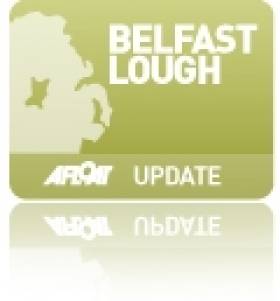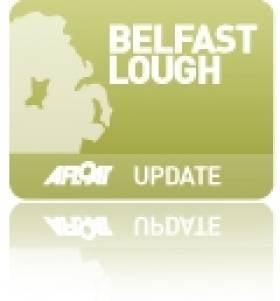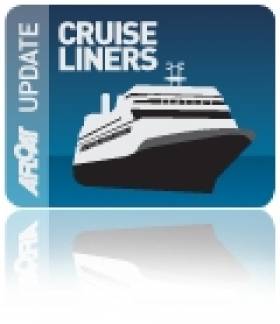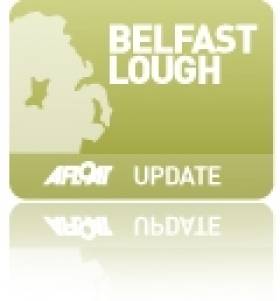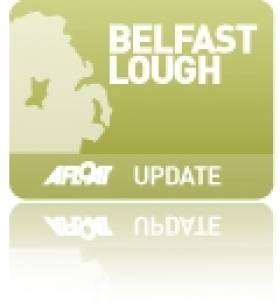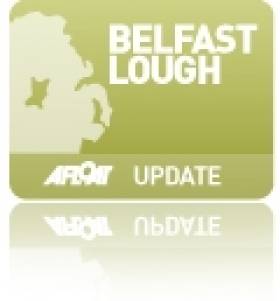Displaying items by tag: Harland & Wolff
Harland & Wolff Completes Rig 'Byford Dolphin' Contract
#RigContract -Harland and Wolff, Belfast has completed the dry docking and SPS Class Renewal Survey of the Byford Dolphin Mobile Offshore Drilling Unit (MODU) during the summer.
The offshore oil rig platform departed Belfast following a six-month dry docking in the ship yard's main Building Dock (556m x 93m) from where the iconic pair of the Samson & Goliath gantry cranes towered above the Byford Dolphin since arrival in January.
Harland and Wolff Director of Marine and Offshore Unit Repair, James Lappin, said "Over the years Harland and Wolff and Dolphin Drilling have collaborated on several occasions, having fabricated pontoons, column extensions, power generation and accommodation modules for other vessels in the Dolphin fleet."
World’s Largest Ice-Class Breaking Tanker Docks in Belfast
#ArcticBelfast - As previously reported on Afloat’s Ferry News, this week Belfast Port had an eighth Stena vessel docked in the harbour which today marks 20 years of ferry operations, writes Jehan Ashmore.
Easily the largest ship is Stena Arctica (belonging to the Stena Group), which is a 117,000 dwt crude oil tanker from an ice-breaker series. The large oil products tanker fitted with an ice-breaking bow is undergoing a major refit for Stena Bulk at Harland & Wolff.
The UK flagged vessel of 249.79m in length on a beam of 44.07m and a draft of 6m is occupying H&W's Belfast Dry-Dock. Stena Arctica is the world’s largest oil tanker that is with an ice class 1A super certification. The design of the vessel allows the tanker to cope in navigating extreme ice conditions with up to 1 metre thick ice.
She is longer and wider than a conventional ice-tanker. Also, the ‘Arctica’ has more built-in steel in her sturdy ice belt, extra-strengthened frames, and an ice-propeller that is more robust than normal.
In a harsh and frozen environment, the ‘Arctica’s’ main engine provides more than 50% of her power. The bridge has a 360-degree view for greater safety in narrow waters. She is optimally designed for safe carriage of oil in the Baltic Sea all year round.
As for the other seven Stena ships in Belfast Port referred above, they are from their Irish Sea North ferry fleet serving out of the harbour. All of the fleet underwent a £6m refit investment programme also at H&W that was completed in Easter. The bulk of the upgrade on these ferries including freight vessels was carried out at the yard over a five month timeframe.
Among those upgraded in the refit programme was the ‘Heysham-max’ class freight-ferry Stena Precision. She belongs to a quartet as route-mate Stena Performance also sails on the Belfast-Heysham service which carries mostly freight and leisure traffic.
The other pair that makeup the ro-ro class quartet remain running for Seatruck Ferries on their Dublin-Liverpool service which is to expand with a third ship next week.
RFA Argus Giant of the Waves Returns Home to Belfast
#NavyHospital - One the largest and most unusual military vessels in the world came home to Belfast for the weekend and where sea cadets had a tour, according to the Belfast Telegraph.
The RFA Argus (A135) will be a feature of the Belfast skyline until tomorrow (today,29 Sept), docked at Gotto Wharf on the Co Antrim side of the Lagan.
RFA Argus was originally an Italian container ship before becoming one of several taken from trade by the Ministry of Defence for use in the 1982 Falklands War.
She was utilised as an aircraft transport, ferrying aircraft on deck, before coming to Harland & Wolff in Belfast during 1985 to be converted into an aviation training ship.
The ship, which is recently back from service in Sierra Leone during the Ebola crisis as part of the Operation Gritrock response, will today (yesterday) welcome on board workers from Harland & Wolff who converted her 20 years ago.
For more on the homeport visit, click here.
Afloat.ie adds that the RFA Argus is registered in Belfast and is as a Primary Casualty Receiving Ship of the Royal Fleet Auxiliary service of the Royal Navy. A 100-bed medical complex can be uniquely tailored to deliver cutting-edge treatment afloat.
She has a flight deck where she can carry Merlin Mk2 helicopters and among the roles they are used for the UK’s Maritime Force Protection and airborne anti-submarine warfare capability for the foreseeable future.
RFA Argus has a gross tonnage of 18,820, a length of 175m and a crew of 80.
As for weapons she is equipped with a single Oerlikon 30mm gun, designed as a ship-protection system to defend Royal Navy frigates from various short range missiles, rockets, grenades and explosives.
In addition a hand operated mounting carrying a single Oerlikon KAA200 automatic cannon. This can fire 1000 rounds a minute and has a range of 2000m.
#OilRigFire – An evacuation of more than 300 factory workers had to be carried out from an oil rig at Harland and Wolff after a small fire broke out during welding operations.
Harland and Wolff said local emergency services were very quickly on hand - however the fire had already been extinguished by H&W Fire Watch on board.
A spokesman said: "We would like to thank the Northern Ireland Fire & Rescue Service for their rapid response and professionalism.
The Northern Ireland Fire and Rescue Service received the call at around 1.45pm and had brought the fire under control by 4pm.
For more The Belfast Telegraph has a report here.
Multi Million Refit of Stena Line Fleet
#Harland&Wolff - A £6million refit of Stena Line's fleet of North Irish Sea ferries finishes with the upgrade of Stena Precision at Belfast's Harland & Wolff shipyard over the Easter period.
Seven ships have been upgraded by Stena Line over the last five months with work being carried out at the Belfast shipyard.
Among them adds Afloat.ie, Stena's Belfast-Cairnryan route Superfast serving sisters VII and VIII with Stena Nordica standing in to cover the refits, before the former Dublin-Holyhead route ro-pax heads for a new career with DFDS Seaways on the Dover-Calais service.
Stena Line's Irish Sea North route manager Paul Grant said, "Over the last five years Stena Line has invested more than £250m in its Irish Sea business". For more, Belfast Live has a report, here.
Byford Dolphin Oil Rig Arrives In Belfast For Refit
#ByfordDolphin - Oil rig Byford Dolphin finally arrived in Belfast for her refit at the weekend, spelling a significant jobs boost for the city's port.
As previously reported on Afloat.ie, the contract to dry-dock and survey the rig – sister to the Blackford Dolphin that the city hosted last year – was announced earlier this month.
Formerly a visitor to Belfast Lough herself for repairs back in 2004, the Byford Dolphin could provide for as many as 1,000 jobs at the Harland & Wolff shipyard, according to the News Letter – which has more on the story HERE.
An Apt Belfast Call Given Cruise Operator’s Relation to Harland & Wolff
#FredOslenH&W – Fred. Olsen Cruise Lines Boudicca (1973/28,551grt) docked this morning at Liverpool following an apt port of call to Belfast, given her berth facing opposite Harland & Wolff Industries is a Fred. Olsen related company, writes Jehan Ashmore.
Boudicca had berthed on the north bank of the Lagan directly across from H&W's Queens Island facility from where ships are dry-docked, repaired, converted in addition to where marine engineering projects are carried out on site.
Also facing opposite Boudicca, the historic pump-house that was used for the dock in which the RMS Titanic was built as previously reported, is to be transformed into a visitor centre for HMS Caroline.
Having completed her call to Belfast yesterday, Boudicca made her final-leg of the cruise when arriving in the early hours at Liverpool Cruise Terminal.
This cruise was the third out of four Irish Sea festive mini-taster cruises ranging from 1, 2 and 3 nights.
All the cruises start from Merseyside for UK guests booked with the 4-star cruise ship operator. During calls to Dublin Port, Irish clients embark from Ocean Pier within Alexandra Basin.
Since Afloat.ie's last report about Boudicca, the German built cruise ship had also made an interim cruise from Merseyside with calls to Dublin, Cork (Cobh) and Belfast.
On her final festive Irish Sea cruise, Boudicca is to depart Liverpool tomorrow night and arrive in Dublin on Saturday.
Harland & Wolff Appoint New Director of Fabrication
#H&Wappointment – Harland & Wolff Heavy Industries has appointment Jonathan Guest as Director of Fabrication, of the Belfast based ship repairer, conversion, engineering and renewable energy manufacturer.
Guest's appointed to the Board of H&W, will see him have responsibility for developing and growing the company's business in the sector and for the execution of its projects.
Following a 3 year Manufacturing Systems Degree, Guest joined the yard's hull outfit office as a Graduate Trainee Manager in 1995, promoted to Manfacturing Manager in 2001 before leaving to develop his career with Crane Stockham Valve, McMullen Architectural and MJM Marine Limited.
In 2011 he won the Institute of Directors (NI) "Global Director of the Year" award and is a specialist in Lean Improvement activities.
This latest appointment follows another key position taken when James Lappin took the role of Director of Ship & Offshore Unit Repair last month.
Harland & Wolff Appoints New Director of Ship & Offshore Unit Repair
#H&Wdirector- Harland & Wolff Heavy Industries has appointed James Lappin as the new Director of Ship & Offshore Unit Repair.
The new position will involve total responsibility for developing and growing the Belfast company's business in this sector and execution of its projects.
Lappin who is a Mechanical Engineer joined Harland & Wolff as a Graduate Trainee Manager in 1999 before leaving to develop his career with blue chip offshore energy companies including BP, KBR and Fred Olsen Renewables.
In 2011 he re-joined H&W as Ship & Offshore Unit Repair Manager, overseeing a range of projects.
Among them as previously reported on Afloat.ie the Husky SeaRose FPSO (see photo) a floating production storage offshore vessel and more recently the Blackford Dolphin Drilling Rig project.
#H&Wlosses - Harland & Wolff, the shipbuilder-turned renewable energy giant manufacturer, suffered a £3.8m loss in 2013, according to newly-filed results.
Directors have said that the "very unsatisfactory" results were down to escalating project costs, leading to a review of the organisation, its structure and processes.
The group generated an operating loss of £3.8m on a turnover of £32m after two profitable years of trading and a good performance in a number of sectors in 2013.
In its annual report, the company said its flotation tank project with Norwegian firm Kvaerner Verdal AS had incurred "significant cost overruns".
However, the annual report said that the overall financial position of the company remained strong and debt free and that it was taking measures to ensure the losses were "a one-off and will not be repeated".
To read much more on this story, The Belfast Telegraph has a report HERE.


























